Assisted Reproduction in Bison
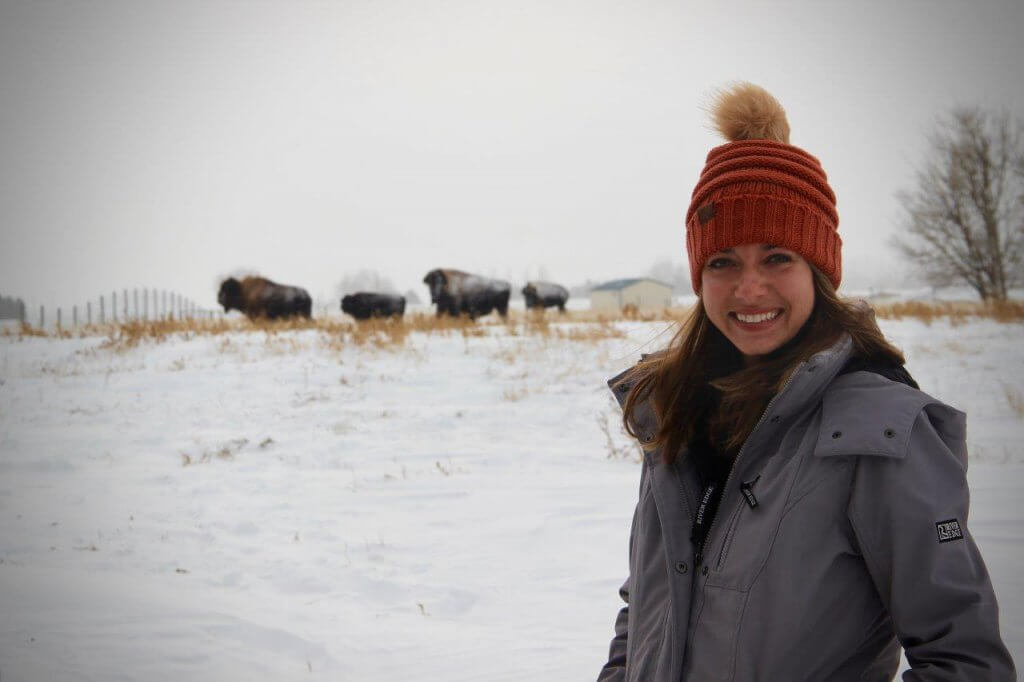
Researcher Miranda Zwiefelhofer surveys herd of wood bison at one of the University of Saskatchewan’s Livestock and Forage Centre of Excellence’s facilities. Photo credit Eric Zwiefelhofer.
North American bison are made up of two distinct subspecies, the smaller plains bison and the larger wood bison. They are considered Near Threatened by the International Union for Conservation of Nature and Natural Resources.
Threats that impact the bison today include diseases in large free-roaming wild herds, hybridization between the bison subspecies and historical hybridization with cattle.
The wood bison are at an increased risk as all accessible wood bison herds in the world can be traced back to 11 founding bison. The remaining bison are locked away in the Greater Wood Buffalo National Park Region in Canada. The region is endemically infected with diseases such as Tuberculosis and Brucellosis making the herds inaccessible. Wood bison cannot be removed from these herds and assisted reproduction is a feasible method for accessing these valuable genetics in a bio-secure manner.
Bison Reproduction
Great strides have been taken in the past 15 years by academic institutions and zoological societies to better understand bison reproduction and create tools to assist in bison reproduction—otherwise known as assisted reproduction.
Female reproductive anatomy is primarily composed of two ovaries, two oviducts, a uterus with two uterine horns, a cervix and vagina. The ovaries have many fluid-filled follicles, each containing one oocyte which is the technical term for a mammalian egg.
Many people have heard of the bison “rut” each fall. From mid-July to September bison males bellow, wallow and fight for the top position in the herd. The victorious winner is rewarded with mating the females and the chance to share his genetics. This testosterone-driven phenomenon results in a synchronous calving event in the spring.

Plains bison bull at Custer State Park during the rut. Photo credit Miranda Zwiefelhofer.
One major difference between cattle and bison is that bison are seasonal breeders. Many people do not know that if female bison do not get pregnant in the short “rut” window, they can still get pregnant for several months, resulting in the odd calf born in late summer and fall.
Non-pregnant female bison will ovulate a follicle and release an oocyte for fertilization approximately every 20 days from August to February. This is called the ovulatory season. Unlike in cattle, bison stop ovulating from March to July in what is called the anovulatory season. Meanwhile, female cattle continually ovulate throughout the entire year.
The onset of reproductive seasonality in male (the rut) and female (ovulation of follicles) bison is triggered by the decreasing photoperiod (shorter day lengths) at the end of summer.
Each oocyte includes an inner ooplasm (the 1-cell egg), a tough outer protective casing called the zona pellucida and the hundreds of tiny granulosa cells which are attached to the outside of the zona pellucida and nurture the inner cell.
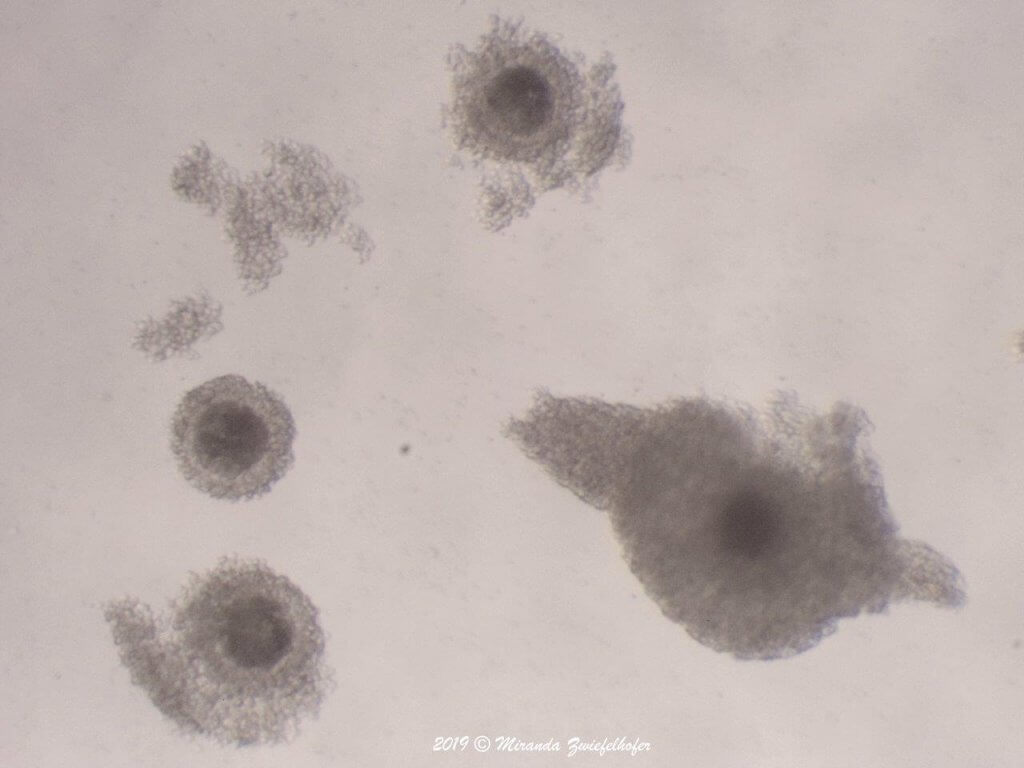
Bison oocytes (eggs). If the oocyte gets fertilized by a sperm, the cell will begin to divide and continue to migrate into the uterus. In about 265 days, happy and healthy bison calves are born. Credit MZ.
After the follicle ovulates, the oocyte is picked up by the hair-like fingers at the tip of the oviduct and is pushed further down the oviduct by contractions. The oocyte only has approximately 8 hours to be fertilized by a sperm. If a sperm does not find the oocyte, the oocyte will die and the female bison will ovulate another follicle in ~20 days.
If the oocyte does get fertilized by a sperm, the cell will begin to divide and continue to migrate into the uterus. The embryo will secrete a protein that maintains pregnancy. In approximately 265 days, the gestation length of the bison, happy and healthy bison calves are born.
Assisted Reproduction
The use of assisted reproductive techniques has become increasingly popular in humans, domestic species such as cattle, and for use in threatened and endangered species. The term assisted reproduction encompasses several techniques that simply unite bison germplasm (egg and sperm) which would not have a chance to meet because of geographical restrictions or other limiting factors.
Assisted reproductive techniques are tools that can help with infertility, commercial gain and conservation efforts. We emphasize that there is no genetic editing that occurs in any of the techniques described here.
Artificial Insemination (AI)
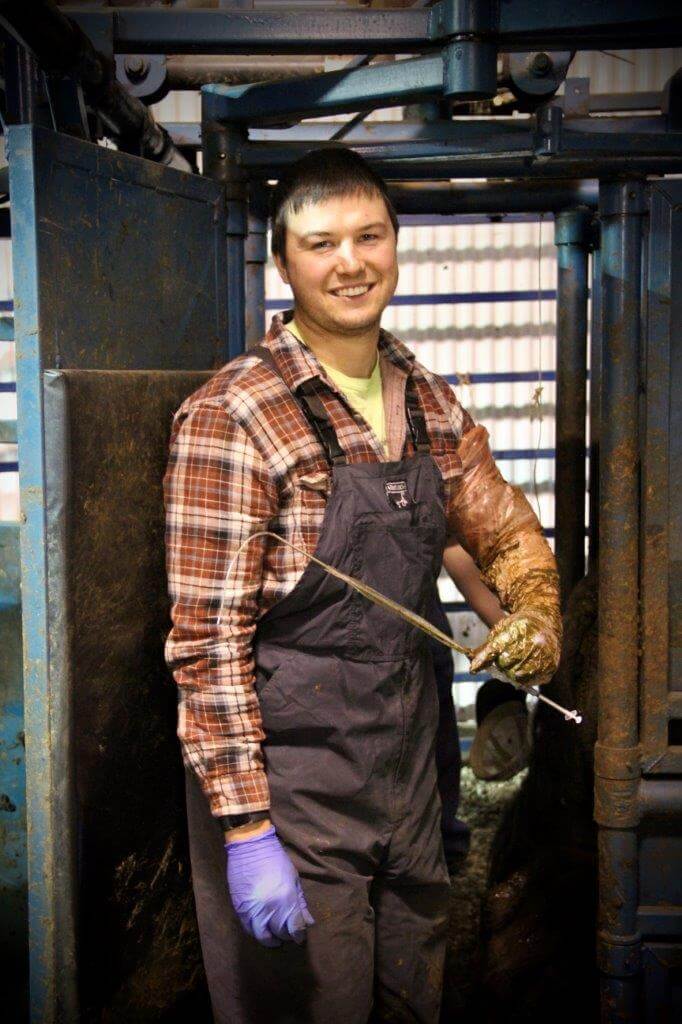
Eric Zwiefelhofer, PhD: A single semen sample can be loaded into a straw containing millions of sperm, then frozen and stored indefinitely in liquid nitrogen at -320.5° F until used. Credit MZ.
The use of ‘artificial’ can be somewhat misleading—when in fact all that is happening is the replacement of a live bull with a straw of semen, containing millions of sperm.
Semen can be collected from bison bulls in a chute system or even from a bull that is sedated. The semen is then brought to the laboratory where it is assessed for quality. This includes tests for concentration and movement of the sperm (motility) by microscopy.
A single semen collection from a bison bull can yield billions of sperm in a 5-10 mL sample. To freeze the semen, the semen sample is diluted using an extender which contains nutrients and cryoprotectants for the sperm to survive freezing. The semen sample can then be loaded into a straw containing millions of sperm and frozen.
The sample can then be stored indefinitely in liquid nitrogen (-320.5° F) until use. In 2015 the Toronto Zoo reported a bison calf born using artificial insemination from semen frozen for 35 years (https://www.torontozoo.com/press/!newsite-Releases.asp?pg=20150817). A single semen collection can yield hundreds of straws of semen to inseminate hundreds of cows.
The artificial insemination procedure is safe and quick (~1 minute) in bison. Female bison can either be inseminated after natural estrus occurs or after estrus is induced. Estrus is the natural behavior of a female for a short time where she is receptive to the male for breeding. This phenomenon occurs approximately 24 hours prior to ovulation described above.
The straw of semen is retrieved from the liquid nitrogen vessel and thawed in water at approximately 98°F for 1 minute. The straw is then loaded into a special pipette. The female is brought to the chute and a gloved hand is inserted into the rectum, while the pipette containing the semen straw is inserted into the vagina. The pipette is manipulated through the cervix using the gloved hand in the rectum. Once the uterus is reached, the semen (containing millions of sperm) is deposited and the sperm will begin the migration to the uterine horn and oviduct in search of an egg to fertilize.
In Vitro Fertilization
Simply stated, in vitro fertilization (more commonly referred to as IVF) combines an egg and a sperm in the laboratory. We can collect eggs from bison in a hydraulic chute, sedated bison on the ground and even from bison that have recently died.
The oocyte collection process is simple, quick, and pain free. It is very similar to oocyte collection in women, they even get an epidural so they do not feel a thing. With the use of ultrasonography, the ovaries are imaged and the follicles, which contain the oocytes, are aspirated (i.e. removed) using a vacuum pump. The follicular fluid is then filtered and the oocytes are recovered using a microscope. The oocytes are then washed and matured overnight.
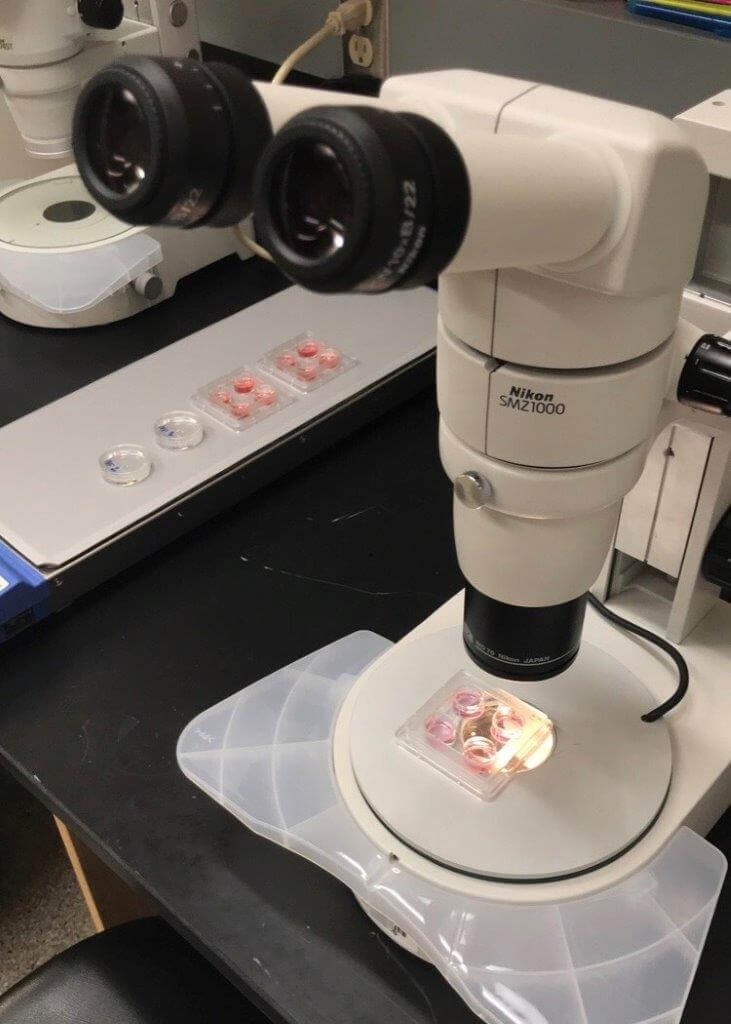
Bison in vitro fertilization (IVF) combines an egg and a sperm in the laboratory. Credit MZ.
The following day, either fresh, cooled or frozen bison semen can be used to fertilize the matured oocytes. Unlike in artificial insemination, where one straw of semen can fertilize one female, in IVF a single straw of semen can fertilize hundreds of oocytes. This means that if you have rare and valuable semen, IVF allows these genetics to be passed on in many individuals rather than a single offspring. A small sperm sample is added to the media containing the oocytes.
The following day after fertilization the extra sperm and granulosa cells are removed and the fertilized oocytes (now referred to as embryos) are placed in clean media. We then culture them in an incubator for another 6 to 7 days.
During this time the embryo cells divide until it reaches around 32 cells where it begins to compact into one single cell mass. The cell mass then creates a small bubble inside it called a blastocoel. The blastocoel gets bigger and bigger until it actually hatches out of the zona pellucida (the outer casing).
For the purpose of conservation, it is best to freeze the embryo prior to hatching. Freezing the embryo allows us to keep the embryo in liquid nitrogen at -320.5° F. This allows us to keep the embryo indefinitely and transport the embryos in a bio-secure manner. Embryos are also able to be washed free of disease-causing agents such as bacteria and viruses.
IVF is an important tool for conservation. When there are only a few remaining animals in a herd or in a species, it is essential to make the most out of the situation. The northern white rhino is technically extinct with only two remaining females in existence. Embryos have been produced from collected oocytes and frozen semen preserved from a dead northern white rhino male through IVF. This breakthrough technology has also resulted in the birth of cheetah cubs which are considered a vulnerable species.
In vitro fertilization can also be used in domestic species when a small amount of semen is available from an old bull or when a bull dies unexpectedly. Two units of semen from a superior Wagyu bull (Mayura Itoshigenami Jnr) from Australia just recently sold for $140,000 AUD ($108,000 USD). These two units of semen could be used in IVF to fertilize hundreds of oocytes from multiple cows.
Embryo Transfer into Surrogate Bison Females
The incorporation of embryo transfer (ET) is a bio-secure approach to bring new genetics into a bison herd as it doesn’t require the movement of the animals themselves. Embryo transfer has been used since the 1970s in cattle with great success. The primary goal of ET in bison is for conservation purposes.

Wood bison IVF embryo produced at the University of Saskatchewan, SK, Canada. In embryo transfer it’s important to match the age of the embryo to the estrus cycle of the surrogate mother. But none of the calf’s genetics will come from the surrogate mother. Credit MZ.
An important aspect of ET is to match the age of the embryo to the time since estrus has occurred in the surrogate female. Naturally, ovulation and fertilization of an egg will occur approximately 1 day after estrus in a bison female. However, if there isn’t a male to naturally breed the female, the female will still ovulate, but no fertilization will occur. The infertile egg will continue to migrate into her uterine horn.
This is where we can incorporate the use of ET in female bison. Embryos produced in the lab will be approximately 7 to 8 days old (i.e., 7 to 8 days since fertilization has occurred). This means that in order to have success using ET, a surrogate female must be selected that was in estrus 8 to 9 days before as she will have an infertile egg in her uterus that is the same age as the embryo.
The in vitro-produced embryo can then be transferred non-surgically into the uterus. The body thinks that the embryo that was transferred is its own and nourishes it.
Probably the most interesting part about a calf produced through ET, is that none of its genetics will come from its surrogate mother. This means that you could produce an embryo from a pure plains bull and cow and transfer it into a pure wood bison surrogate—the resulting calf will be 100% plains genetics even though a wood bison carried it around for over 8 months in her uterus.
Wood and plains bison calves have been born from transferred frozen IVF embryos. Check out one of our more recent press releases from frozen IVF embryo bison calves born; https://news.usask.ca/articles/research/2020/usask-researchers-in-vitro-fertilization-successful-with-baby-bison.php. Future work focuses on improving these technologies to increase effectiveness.
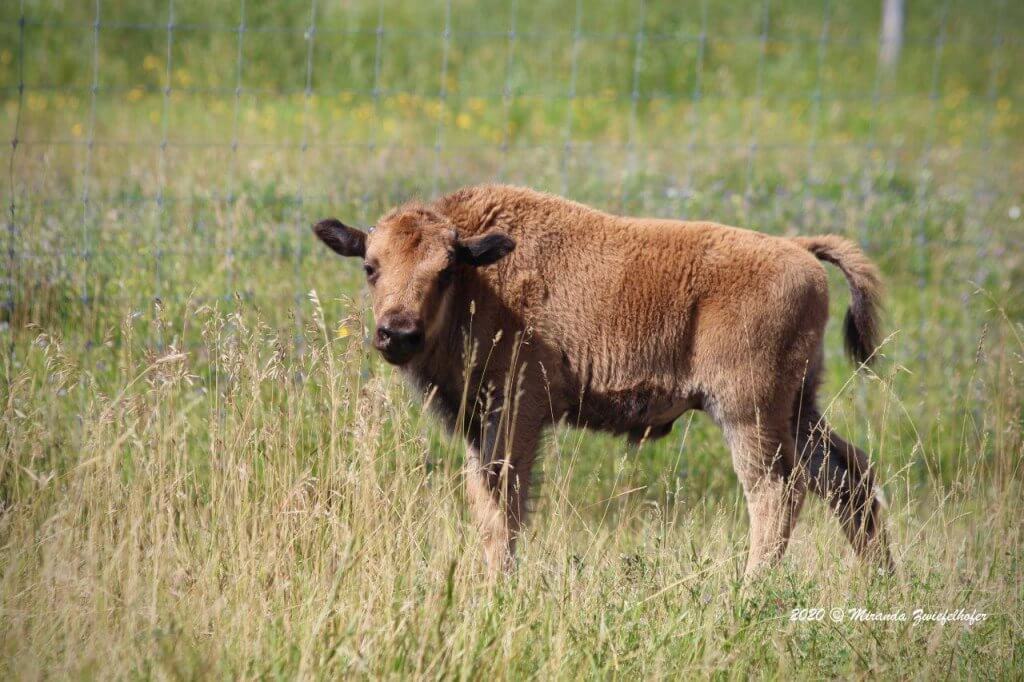
2020 Wood bison calf from frozen IVF embryo at the University of Saskatchewan. Credit MZ.
Embryo transfer is a widely-accepted technology in the cattle industry. In 2019, more than 1.4 million embryos were produced in cattle according to the International Embryo Technology Society. The National Bison Association currently does not allow “in-vitro fertilization or other artificial reproduction practices for any purposes other than scientific research.”
However, these technologies are vital for conservation efforts. They can move genetics without transporting live bison which can be a huge biosecurity issue. With the assistance of wildlife veterinarians, bison can be sedated from a helicopter and semen or oocytes can be safely collected from them. Less than 30 minutes later, the sedation can be reversed and the bison is free to rejoin the herd.
The semen and eggs can then be sent back to the laboratory where eggs can be fertilized with sperm and produce embryos. Both the embryos and semen can be frozen for long-term usage and stored in vessels containing liquid nitrogen.
These frozen embryos and semen could then be shipped thousands of miles using FedEx or UPS (I’m not kidding—used extensively in the cattle industry) to other herds both domestically and internationally. Embryos/semen are transported in a dry shipper which holds liquid nitrogen vapor at a temperature of less than -238° F for upwards of two weeks. A single tank containing hundreds of units of semen and embryos could be shipped for less than $1000—I can’t imagine how much it would cost to ship hundreds of live bison over a thousand miles.
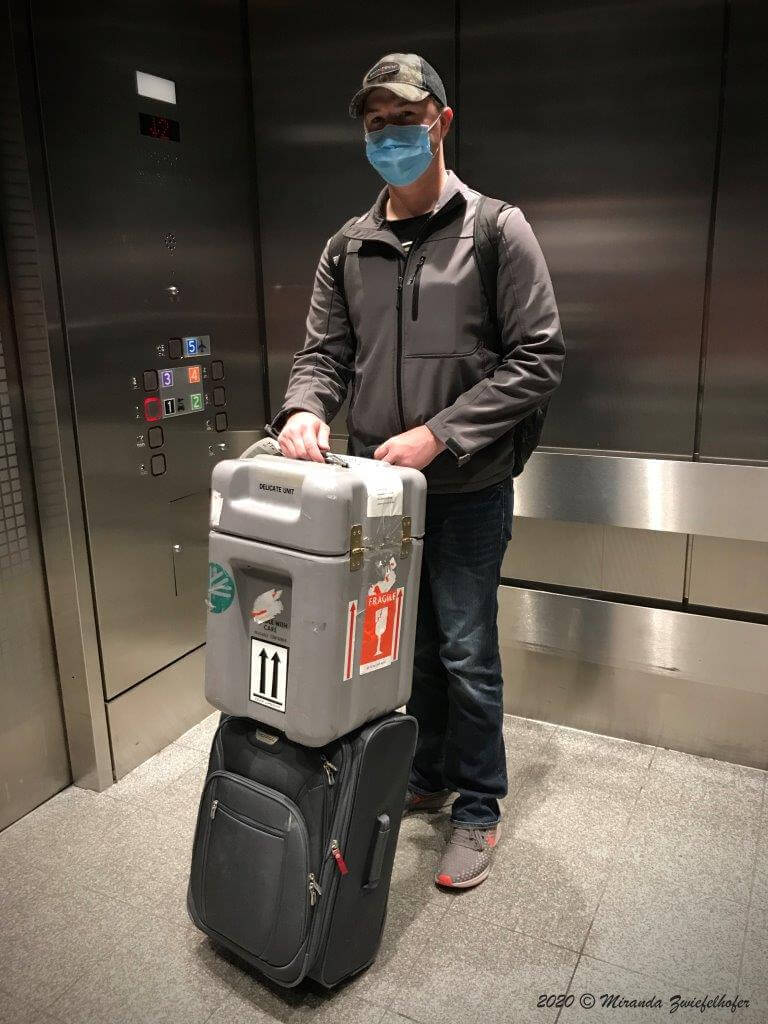
Eric Zwiefelhofer traveling with IVF wood bison embryos using a dry shipper. Credit MZ.
Imagine if the early bison conservationists had access to these reproductive technologies. Bison wouldn’t have to be rounded up off the prairies for days, placed in corrals, and forced onto rail cars to be transported for hundreds or thousands of miles. Semen and embryos could be produced from them and could be transported safely through FedEx or even as your checked-baggage on a flight.
The movement of genetics is a more economic option through the use of reproductive technologies. It also substantially decreases the transport stress of moving live bison resulting in fewer deaths.
Research is constantly evolving making assisted reproduction more effective and easier to accomplish. As seen in many endangered species, it is crucial to develop these technologies prior to them being needed. For the purpose of conservation in bison, collaborative efforts are in the works to implement these technologies to access rare genetics locked away in wild herds.
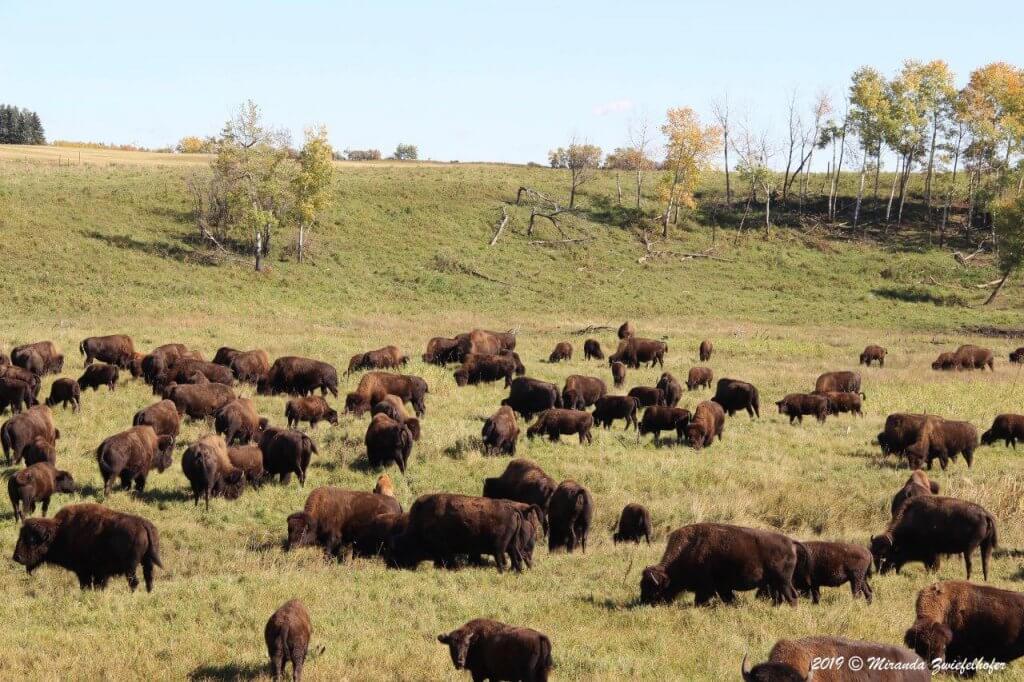
A commercial bison herd in Alberta Canada. Photo credit MZ.
We hope that these technologies will help the long-term health and resilience of plains and wood bison for future generations and that this article may ease some anxiety about the mystery which is assisted reproduction.
Miranda and Eric Zwiefelhofer
 Author bio: Eric and Miranda Zwiefelhofer are a husband and wife team from Wisconsin and Minnesota. They attended the University of Wisconsin-River Falls for their undergraduate education where Miranda graduated with a degree in Biology and Secondary education and Eric in Dairy Science. They are currently living in Saskatoon, SK, Canada for their graduate studies in the Department of Veterinary Biomedical Sciences at the University of Saskatchewan which is a research-based program. They both specialize in reproductive physiology and advanced reproductive techniques. Eric specializes in oocyte collections, artificial insemination and embryo transfer while Miranda specializes in the in vitro production of embryos. Miranda is a PhD Candidate and will defend her thesis soon on Strategies for the use of reproductive technologies in bison. Eric obtained his PhD in January 2020 on Ovarian synchronization in cattle. He is currently working as a postdoctoral researcher for a second year with the University of Saskatchewan and the Toronto Zoo working on protocols to produce female offspring in bison. (Recent press release; https://news.usask.ca/articles/research/2021/wcvm-today-research-team-produces-first-female-bison-pregnancy-with-sex-sorted-sperm.php)
Author bio: Eric and Miranda Zwiefelhofer are a husband and wife team from Wisconsin and Minnesota. They attended the University of Wisconsin-River Falls for their undergraduate education where Miranda graduated with a degree in Biology and Secondary education and Eric in Dairy Science. They are currently living in Saskatoon, SK, Canada for their graduate studies in the Department of Veterinary Biomedical Sciences at the University of Saskatchewan which is a research-based program. They both specialize in reproductive physiology and advanced reproductive techniques. Eric specializes in oocyte collections, artificial insemination and embryo transfer while Miranda specializes in the in vitro production of embryos. Miranda is a PhD Candidate and will defend her thesis soon on Strategies for the use of reproductive technologies in bison. Eric obtained his PhD in January 2020 on Ovarian synchronization in cattle. He is currently working as a postdoctoral researcher for a second year with the University of Saskatchewan and the Toronto Zoo working on protocols to produce female offspring in bison. (Recent press release; https://news.usask.ca/articles/research/2021/wcvm-today-research-team-produces-first-female-bison-pregnancy-with-sex-sorted-sperm.php)

